Layer 1 Blockchain Comparison- What is the Future of Web3?
Let's compare some of the main layer one blockchains: Ethereum, Cardano, Solana, Binance Smart Chain, Zilliqa, Algorand, Internet Computer and Avalanche.

The purpose of this article is to compare some of the main features of the following layer one Blockchains: Ethereum, Cardano, Solana, Binance Smart Chain, Zilliqa, Algorand, Internet Computer, and Avalanche.

The Blockchain Trilemma
You've probably already heard about the famous blockchain technology trilemma: scalability, speed, and security. Many of the current Layer 1 blockchains solve two of them to a greater or lesser extent. Satisfying all three requirements simultaneously is complex, and even more so when you do it while trying to keep costs down.
Due to being meticulously constructed over a period of several years by one of the largest R&D operations in blockchain, the Internet Computer has solved this trilemma better than any other blockchain by an order of magnitude, as the following research will show, and this is one of the fundamental reasons why InfinitySwap decided to utilize the platform.
Although Polkadot is technically a 0-layer blockchain, known as a multi-chain protocol with heterogeneous sharding, it will nonetheless be included in this comparative analysis.
Comparison between Layer 1 Blockchains
Speed
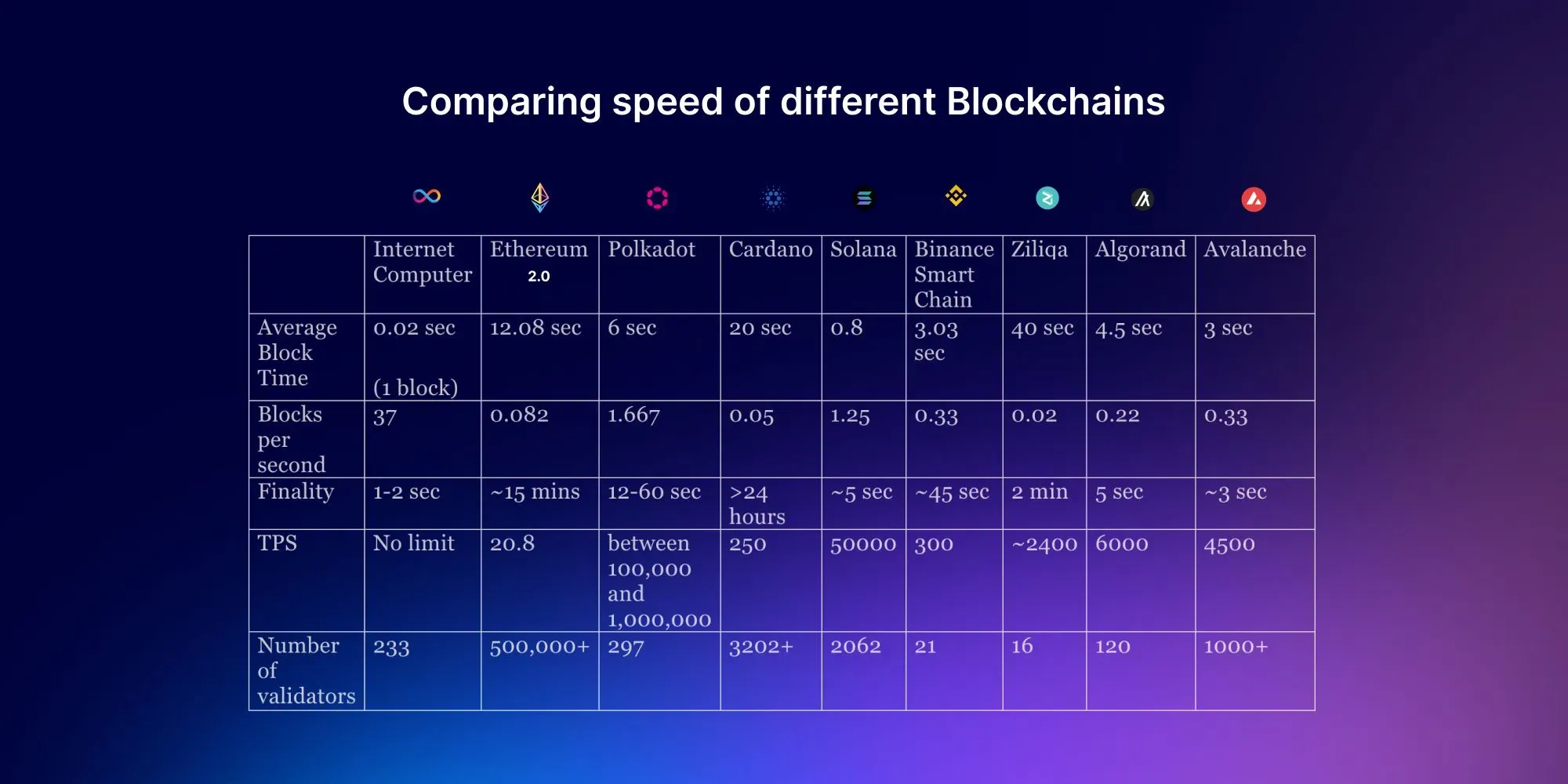
*Sources: Ethereum, Polkadot, Ziliqa, Algorand, Avalanche, Internet Computer
In a quest for bragging rights, the parameters most cited by blockchain enthusiasts are those related to speed. Unlike security or scalability, speed has easily measurable parameters that make it easier to rank the winners. The Internet Computer asserts a dominant claim here, being able to serve smart contracts at web speed!
The transaction speed is calculated using three metrics:
- Block Size: The amount of data (in bytes) that can be contained in a single block.
- Block Time: Time needed to create the next block in a blockchain.
- Average Transaction Size: How large the average transaction on the blockchain network tends to be.
Often, performing this calculation can be complicated by the fact that some blockchains have been gradually increasing the size of their blocks over the years to accommodate transaction demand.
The speed of a blockchain network directly impacts the time it takes the end-user to make a transaction from one account to another. This time is measured by the "Transaction Finality" parameter, which indicates the amount of time we have to wait to guarantee that cryptocurrency transactions cannot be altered, reversed, or canceled after they are completed.
In order to position themselves in the market, some blockchains often use "Block Time" to refer to "Transaction Finality." The former does not consider parameters such as latency (the amount of time it takes for a blockchain network to confirm a transaction), which is included in the "Transaction Finality." The actual speed of a blockchain is checked here.
The last key metric is the TPS.
Transactions Per Second refers to the number of transactions that a network is capable of processing each second. This is only a theoretical number calculated as transactions per block, divided by block time.
Solana has aggressively promoted itself on a supposedly high transaction volume and low block time. Solana's Block Time is indeed fast (it is the fastest after the Internet Computer), but this is very different from the transaction finality. It usually takes several blocks before the transaction is included in a block and committed to a consensus state. Solana uses "Optimistic Confirmation" which requires 32 votes; thereby, the "Transaction Finality" is about 5 seconds.
Additionally, Solana uses Proof of History as a tool in its Proof of Stake consensus. This technical innovation addresses a problem that other blockchains don't even have to begin with. Namely, blocks must be produced serially, so Proof of History introduces a verifiable delay to synchronize the timing of block production.
Algorand and Avalanche are the other two projects that deserve to be mentioned in this section. Although neither has a better block time than Solana, they equal or improve the transaction finality time. Therefore, we can state that, after the Internet Computer, the blockchain with the best speed data is Avalanche. All the other blockchains not mentioned in this paragraph still have a lot of work ahead of them if they want to improve on this metric, if indeed they can.
The Internet Computer uses its innovative Chain Key technology to finalize transactions that update smart contract states in 1–2 seconds. If you look at this prestigious study on tolerable waiting time, Miller considers that an individual perceives awaiting awareness after approximately 2 seconds, so the Internet Computer can be said to be the only L1 capable of serving a tolerable UX interaction with smart contracts.
Specific applications, such as online games, require that responses be provided to users in milliseconds. The Internet Computer solves this by splitting smart contract function execution into two types, known as "update calls" and "query calls."
- Update calls are those we are already familiar with and take 1–2 seconds to finalize their execution.
- Query calls work differently because any changes they make to state (in this case, the memory pages of canisters) are discarded after they run.
Essentially, this allows query calls to execute in milliseconds.
Furthermore, at Genesis, the "Network Nervous System" subnet was launched with 28 nodes, and the application subnets have 7 nodes each. The Network Nervous System, which is governed by the votes of the neuron holders, decides the size of a given subnet. On the Internet computer, subnets are blockchains that Chain Key cryptography combines into a single blockchain.
The Internet Computer continues to grow exponentially, with thousands of nodes planned by the end of the year, and the transactions per second (TPS) of a single subnet will be multiplied by the number of subnets created. For this reason, there is no limit to how far TPS can go.
If you wish to consult the current data of the table above, please visit the following links: Internet Computer, Ethereum, Polkadot, Cardano, Solana, BSC, Zilliqa, Algorand and Avalanche.
Scalability & Storage
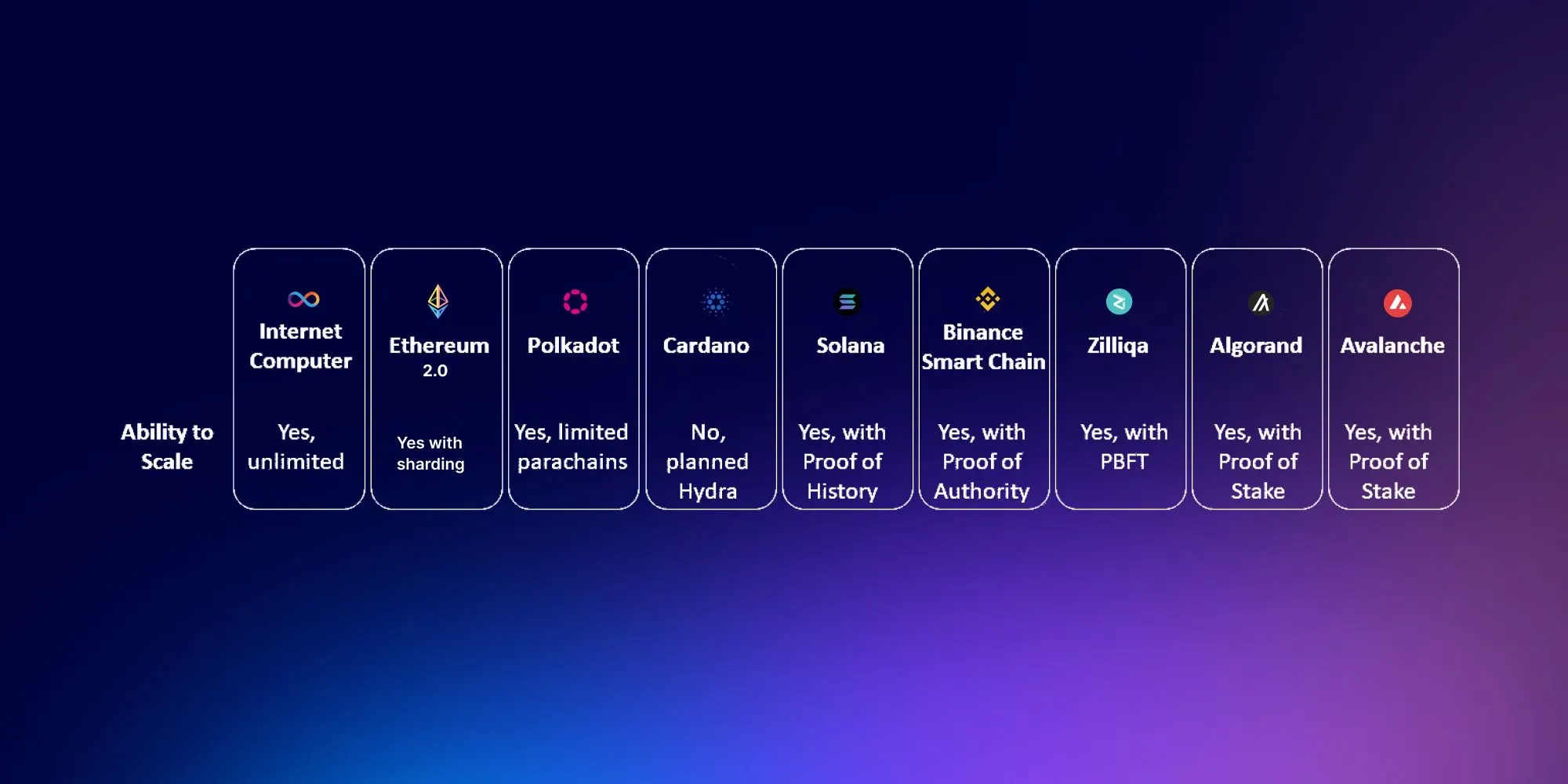
The scalability of blockchain networks is the ability to support high transaction throughput and future growth. This means that as the adoption of blockchain technology accelerates, the performance of a scalable blockchain will not be affected.
Bitcoin has suffered from scalability issues over the past few years due to the limitation of the Proof of Work consensus model. Currently, Ethereum can leverage Layer 2 solutions to overcome scalability issues, but the nodes run on big tech cloud platforms such as Amazon Web Services (AWS), thus sacrificing decentralization.
Ethereum has migrated from Proof of Work to Proof of Stake in its update called "London." This update allows it to improve the capacity and scalability of this blockchain with 64 shard chains (Ethereum 2.0 spreads the network load across 64 separate shards, with one Beacon Chain to rule them all). These shards give Ethereum more capacity to store and access data, but they aren't used for executing code.
Like Ethereum 2.0, Polkadot also has a main chain, called the Relay Chain, with several shards called parachains. The number of parachains is limited and is currently estimated at about 100.
As mentioned in the previous section, subnets in the Internet Computer are blockchains that Chain Key technology combines into a single blockchain that increases its capacity with demand (unbounded capacity) and provides a roadmap to infinite scalability. The potential number of subnets is unlimited.
On the other hand, Binance Smart Chain achieves scalability by sacrificing decentralization. In its consensus model, it uses only 21 validators (Proof of Authority) which would appear to make it the most centralized blockchain.
In the meantime, Cardano is still waiting for Hydra, its layer 2 solutions, the same solution that Matic (Polygon) has been offering Ethereum for quite some time now.
Like how Bitcoin and Ethereum sacrificed scalability, Solana sacrificed decentralization. Its "innovative" Proof of History (PoH) adds a new problem that does not exist in other blockchains. Each day, this protocol creates a tremendous amount of transaction history data that needs to be stored (more than 2 TeraBytes per year).
Its size is even more significant than the total data accumulated by the top ten blockchain networks combined. Solana stores this immense amount of data in Arweave (a decentralized storage network) so that its validators only store data from the last two days.
In this way, Solana puts transaction history in the hands of other chains governed by another community.
In addition, Solana's scalability is often in the spotlight. The network has, unfortunately, experienced a number of outages. The network is sometimes unable to cope with a surge in activity, a problem Solana called "resource exhaustion."
Finally, let's examine Avalanche and Algorand. Avalanche network is a platform built by three compatible blockchains: the Exchange Chain (X-Chain), Platform Chain (P-Chain), and Contract Chain (C-Chain). Each subnet, managed on the P-Chain, operates as a mini-network, and all mini-networks join to make the broader Avalanche network. Therefore, scalability will depend on the number of subnets.
The downside is that Avalanche (and Algorand) do not offer their own data storage service. In this case, they do not utilize it to store transaction history, like Solana. They use this decentralized service to share files and store data. Algorand uses the Interplanetary File System (IPFS), and Avalanche uses both Arweave (through Kyve network) and Ceramic. Code and data live together on-chain on the Internet Computer, which is another significant advantage of scalability.
Furthermore, on Ethereum, 1GB of on-chain storage costs about $240,000,000; on Solana costs $840,000; and on the Internet Computer, 1GB costs about $5.

A post by James Bull, AKA @MariusCrypt0 went viral in January 2023, which ranks the scalability of L1 blockchains. Note, in particular, the daily transactions on the IC relative to other chains.
He claims that the following infographic has been constructed:
After 10 months of research, 60 million people seeing his tweets, 5,000 comments, (Bull) has now finally completed his ranking of the 28 most decentralized, most scalable (50k+ TPS) L1-blockchains.

The Internet Computer continues to grow exponentially, with potentially thousands more nodes planned by the end of the year, and the transactions per second (TPS) of a single subnet is multiplied by the number of subnets created.
It uses its innovative Chain Key technology to finalize transactions that update smart contract states in 1–2 seconds. At Genesis, the "Network Nervous System" subnet was launched with 28 nodes, and the application subnets have 7 nodes each. Anyone can review the progress of nodes and subnets on the Internet Computer dashboard, which currently shows that there are 1235 nodes spread over 36 subnets at the time of writing.
Average Transaction Fees
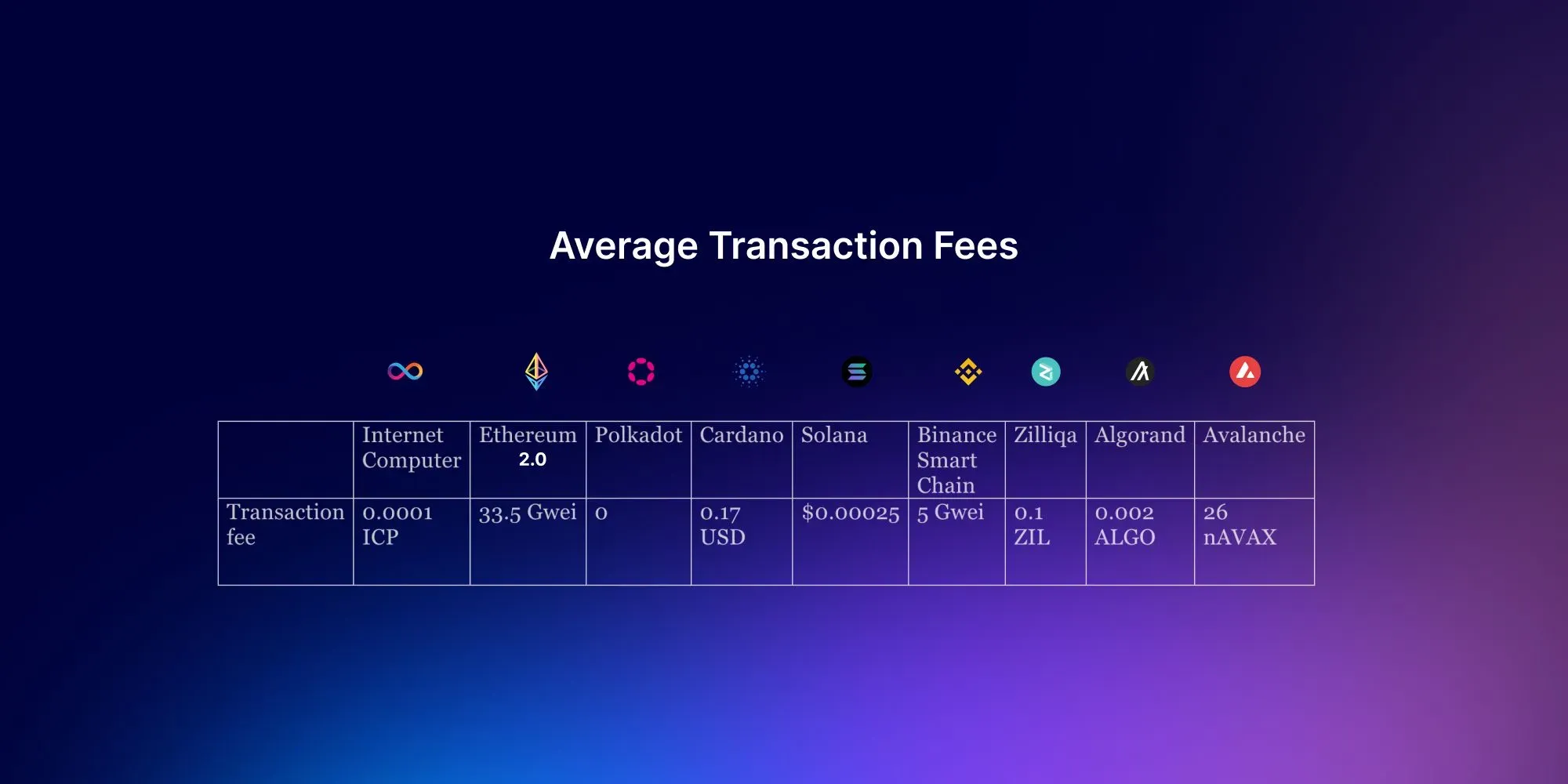
*Sources: Ethereum, Binance Smart Chain, Ziliqa , Algorand, Avalanche, Cardano, Internet Computer
Transaction fees reward miners (Proof of Work) or validators (Proof of Stake) who help confirm transactions.
While Bitcoin fees depend on the size of the transaction in bytes (not to be confused with the number of tokens sent), Ethereum transaction fees take into account the amount of computing power needed to process a transaction, known as gas, which also has a variable price measured in ETH and is directly related to network traffic.
The Binance Smart Chain (BSC) transaction fee is similar to the one proposed by Ethereum. This is hardly surprising, given that BSC is essentially a copy of Ethereum. They have simply changed the consensus model to improve some limitations of the latter (and it must also be said, to worsen others, such as decentralization).
Finally, other blockchains such as Algorand and the Internet Computer offer a negligible fixed fee that depends on the value of their token (0.001 ALGO and 0.0001 ICP, respectively), while using Polkadot costs nothing.
Consensus Mechanisms
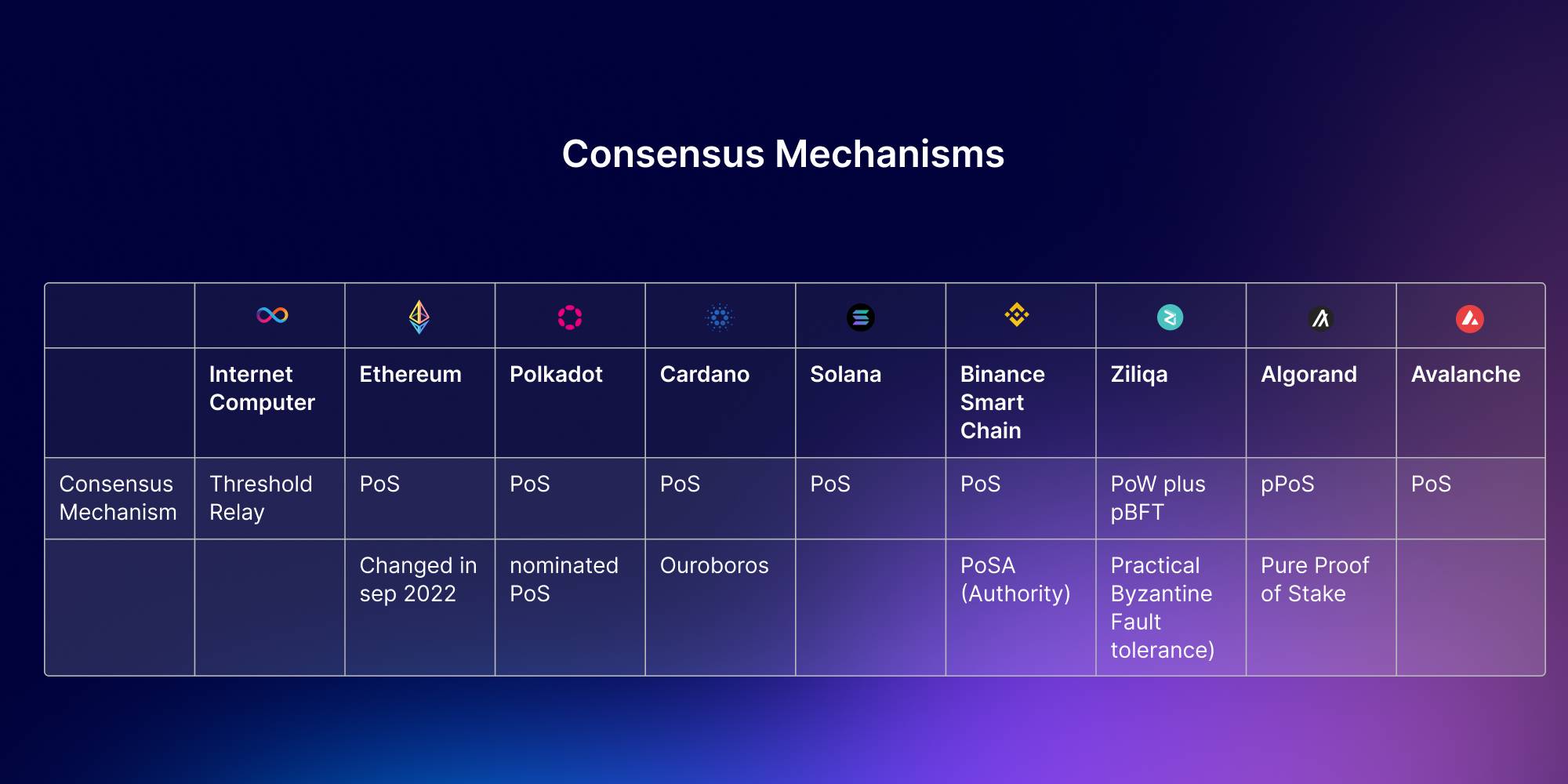
The purpose of a consensus mechanism is to verify that the information added to the ledger is valid. This ensures that the next block to be added is represented correctly and all transactions in the network are updated. This prevents double-spending or invalid data from being recorded.
Proof-of-Work (PoW), the most widespread consensus protocol in cryptocurrency, first came into play with the invention of Bitcoin. Ethereum adopted the upgrade to this - Proof-of-Stake (PoS) in September 2022, and this had long been in the works and represented an immense engineering undertaking and achievement.
Many initial blockchains copied the original Bitcoin code and, as such, also use the Proof-of-Work model.
Although Proof of Work is an innovative invention, it is anything but perfect. Not only does it need significant amounts of electricity, but it is also crippled by transaction limitations, and very few blockchains being created in the present day make use of this consensus.
Proof-of-Stake (PoS) was created as an alternative to Proof-of-Work, to address the various problems associated with the latter. The main advantages of Proof-of-Stake are that it reduces the vast expenditure of electrical power to secure a blockchain and improves the speed of creating each block, which is done in seconds. (milliseconds in the case of Solana, which is nonetheless still 10x slower than the Internet Computer).
Solana, Binance Smart Chain, and Avalanche use the Proof of Stake consensus mechanism. Other blockchains use Proof of Stake based consensus algorithms such as:
Zilliqa employs Practical Byzantine Fault Tolerance protocol (PBFT) in combination with Proof-of-Work. PBFT runs under the assumption that up to 1/3 of the nodes in each shard can be malicious before starting the protocol.
Most layer-1 blockchain networks operate using the Proof-of-Stake (PoS) consensus mechanism or variations of it. Examples of this include Ethereum, Cardano, Avalanche, Algorand, Tezos, and Peercoin, all of which use a traditional PoS model. On the other hand, some networks like the Binance Smart Chain and Solana use variants of PoS.
The blockchain industry introduced the concept of PoS as a way for individual network nodes to participate in a network by committing (or staking) some of their own cryptocurrency (referred to as a network governance token or protocol token) to produce blocks and earn rewards based on the amount they have staked. This model is an improvement to Proof-of-Work (PoW), which requires significant expenditures in dedicated hardware and electricity.
In terms of energy consumption, the Internet Computer is the most efficient, followed by Solana. You can see the details here and in the infographic below.
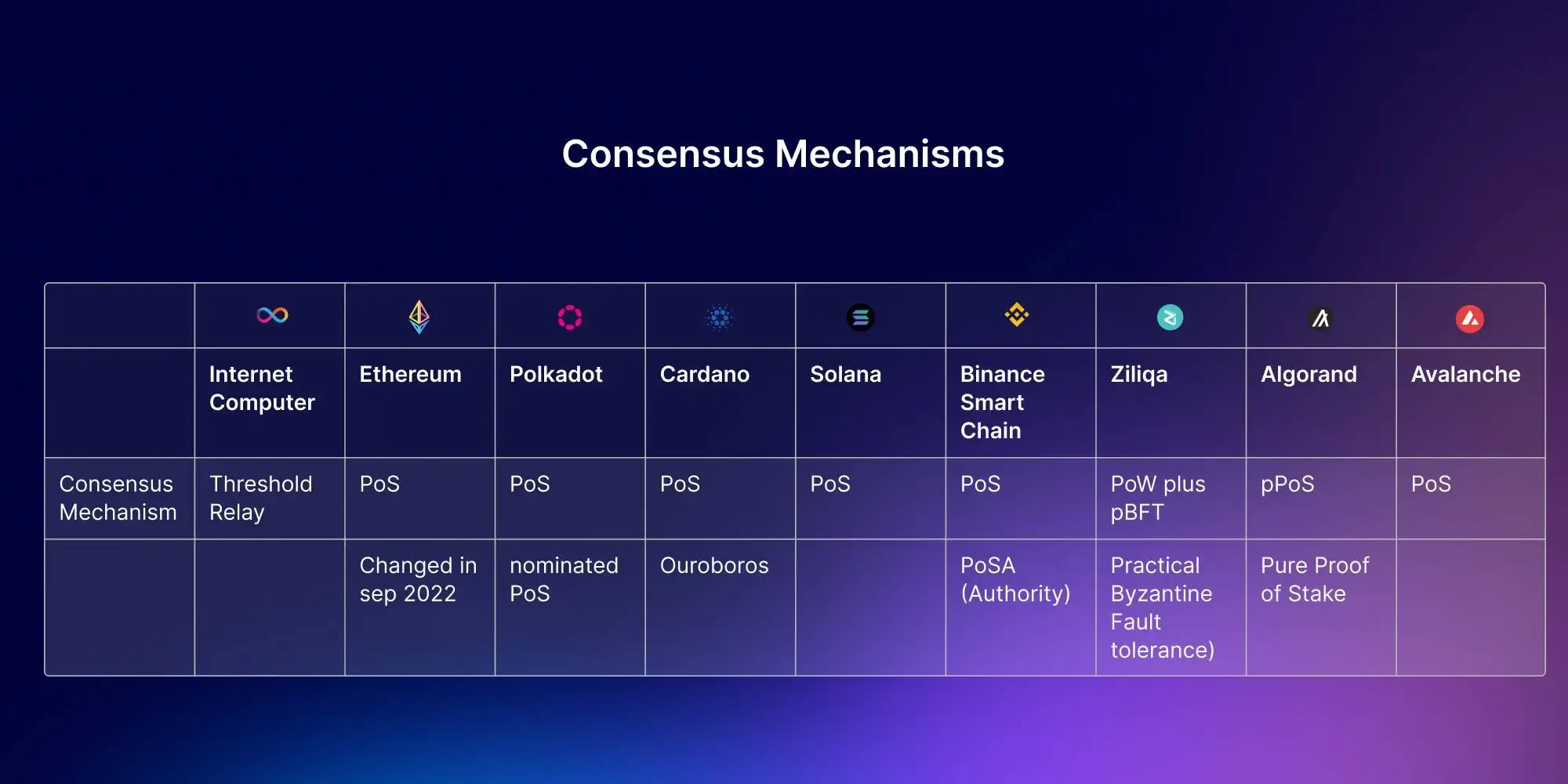
As PoS has become more prevalent, it has also revealed some challenges. One issue is that without the need for dedicated hardware, network nodes (or “clients”) can be set up anywhere, including on corporate servers and cloud-based infrastructure, and activated simply by staking some cryptocurrency. A large proportion of nodes on PoS networks are hosted in the cloud, which raises concerns because it could enable both centralized and decentralized entities to gain control over network operations.
Effects of centralized entities on PoS chains.
Last year, an incident where a German cloud service provider, Hetzner, banned Solana nodes, causing 40% of the network to disappear immediately, sparked a broader conversation in the crypto community about the growing influence of centralized service providers in controlling decentralized blockchain networks. This troubling event has highlighted the potential for cloud providers to disrupt nodes and even shut them down, raising more concerns about the dangers of running a decentralized blockchain in the cloud.
Theft of tokens through manipulation of prices.
Another problem with the PoS consensus mechanism is that cryptocurrency is highly liquid, which can lead to rapid changes in token price and power distribution. An attacker can exploit this. For instance, by manipulating decentralized finance (DeFi) platforms or hacking an exchange, an attacker may gain enough staked coins to compromise the network and profit from it. Since PoS networks often have mechanisms that make it easy to quickly set up new nodes on the cloud, a well-funded attacker can launch an attack by controlling network decisions and behavior.
Proof of Useful Work (PoUW).
The Internet Computer utilizes a consensus protocol that some describe as Threshold Relay, while others prefer Proof-of-Useful-Work (PoUW)'. This is a highly advanced mechanism that is far more efficient than the consensus methods used by other first-layer blockchain networks today.
Threshold Relay emphasizes transaction finality by implementing a Threshold Relay technique in conjunction with the BLS signature scheme and a notarization method to address many problems associated with PoS consensus.
In the Internet Computer consensus, nodes produce a random number, called a "random beacon," which is used to select the next group of nodes and drive the platform's protocols.
Internet Computer’s consensus mechanism model solves existing problems inherent in PoS
It is now clear that any network running in the cloud is very different from a sovereign network built by participants and members of the network, exposing how inefficient PoS is.
This flaw is the reason the Internet Computer has developed the more complex and advanced Proof-of-Useful-Work (PoUW) mechanism. This mechanism involves a blockchain produced by dedicated hardware called “node machines” with similar, standardized computational specifications. These node machines run the highly sophisticated consensus protocol that leans into the power of advanced cryptography, often referred to as Chain Key Cryptography.
Members and participants of a blockchain network establish membership by selecting dedicated node machines in PoUW. These machines are not used for hashing but for producing and processing blocks of transactions that represent smart contract computations.
They are built to the exact standardized specification to ensure that the node machines perform equally the same amount of computation and do not deviate from the group. Instead of competing to perform more computation or hashing, they aim to achieve the same amount of computation, and deviation from this can result in the termination of the machine.
The roles of deterministic decentralization.
The members who control this consensus mechanism and network come from a decentralized autonomous organization (DAO) that runs the Network Nervous System (NNS) in the Internet Computer blockchain. The responsibilities of the DAO include combining node machines that create “subnet blockchains,” which are then connected into a single blockchain using Chain Key Cryptography.
This approach has two essential benefits. Firstly, by carefully selecting nodes based on the node provider, the data center where the node is located, and its geographic location, it is impossible for a single-bodied attacker to easily add nodes to a subnet blockchain, which is a form of “deterministic decentralization.” Secondly, the NNS can remove (or “slash”) nodes that statistically deviate from the group.
This latest innovation is why the CEO and Chief Scientist of DFINITY, Dominic Williams, has stated that the PoUW model is 20,000 times more efficient than the best PoS chain today.
#ICP Proof-of-Useful-Work produces a blockchain that's 20,000X more efficient than the best Proof-of-Stake chain today
— dom.icp ∞ (@dominic_w) January 16, 2023
Yet, it's hosted by a secure & sovereign network of dedicated hardware, with zero corporate cloud – just like Bitcoin uses mining rigs to produce blocks
🔥🚀∞
Because of its sovereign nature, the network is composed of dedicated hardware that is free from the interference of corporate clouds or entities. This deterministic decentralization of the NNS results in a highly efficient network created and maintained by its members — resulting in a completely decentralized blockchain.
Smart Contracts
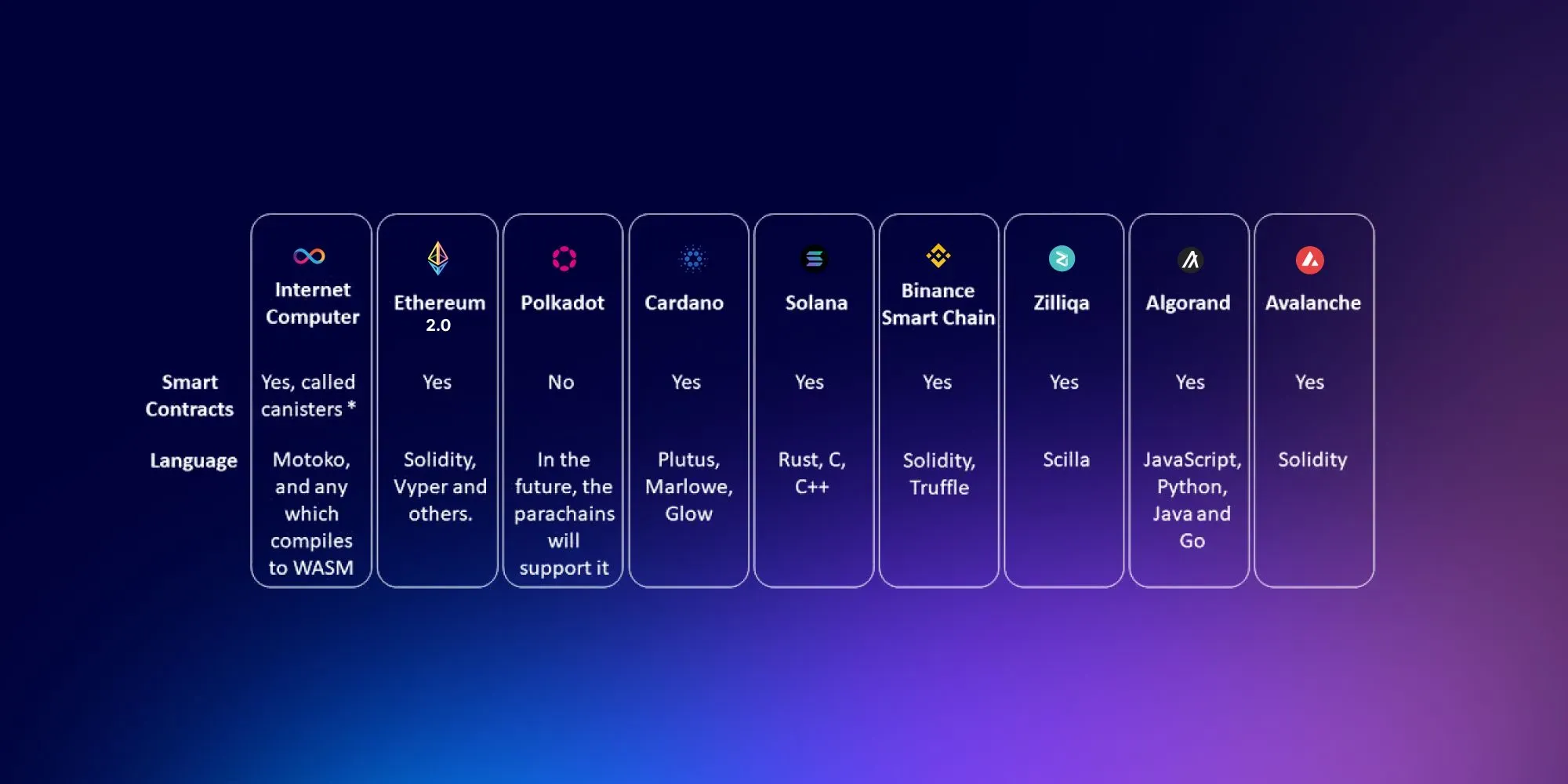
Blockchain ecosystems evolve at different paces. For some, it can be months between essential updates, while others have a higher pace, such as the Internet Computer, which has seen major developments recently.
Since Ethereum launched its first Smart Contract in 2015, other blockchains have followed suit. A clear example is Cardano, which relatively recently, through its "Alonzo Hard Fork," managed to create its first Smart Contract to offer the same service without discernable improvements.
Internet Computer Smart Contracts are called Canisters because they're a bundle of WASM code and Memory Pages, and they are an evolution and specialization of Smart Contracts. Their significant increase in numbers speaks to the growing activity of developers on the network.
Canisters remove bottlenecks using "Orthogonal Persistence," which eliminates the need to maintain and manage external databases or storage volumes (code and data live together on-chain). Other blockchains need to keep their data on other decentralized storage networks (it adds a problem having two different trust domains, in addition to the complexity). The Internet Computer hosts over 240,000 canister smart contracts at the time of writing, but these canisters' main difference is that they are served at web speed.
Smart Contracts will rule the world
The Internet Computer community also approved a proposal to increase the capacity of Canisters from 4GB to 300GB. Very few applications would need more capacity, but you can build your service/system from as many contracts as you need if this were the case.
If the Canister smart contract is limited to 4 GB of memory, there are a number of usage scenarios in which 4 GB of data is not enough, but the capacity of the current sub-networks (approx. 300 GB) is more than sufficient.
In addition, an interface description language called Candid allows canisters to interact with each other regardless of the programming language in which they were developed.
Internet Computer has completed the monumental achievement of adding Smart Contracts to Bitcoin at the end of 2022. It is possible through an application of Chain Key cryptography that directly integrates the networks. Smart contracts on the Internet Computer can now hold, send and receive Bitcoin without the need for private keys.
On Ethereum, developers pay to deploy smart contracts, and people pay to use them. The Internet Computer uses a "reverse gas model" where only developers supply the funds needed to run the applications/contracts that use their gas (called "cycles").
In short, Canisters are Smart Contracts without limitations that enable the reimagination of everything, such as interactive web and dApps on chain (Blockchain Singularity) instead of Big Tech Clouds like AWS, Google, Azure, etc.
Digital Identity Management

The Internet Computer brings a whole new meaning to Identity management through its novel Internet Identity (II) System. This Advanced blockchain authentication guarantees that your data isn't visible, tracked or mined. It enables you to authenticate securely and anonymously when you access decentralized applications (dApps) that use the authentication system.
Authenticate to services using a fingerprint sensor, Face ID, YubiKey, and more.
Internet Identity is constantly being refined to make it compatible with more and more devices. The following guide explains how to set up authentication for an existing Identity Anchor that was set up either on your phone or using a security key.
In other blockchains, such as Ethereum, users need external wallets like Metamask to interact with decentralized applications.
Below you can see the difference between Ethereum and the Internet Computer.
Dapps on Internet Computer:
- Create an Identity.
- Go to a website and use a Dapp for free.
- Or you can use IC native Wallets to authorize such as the defacto Bitfinity Wallet
Dapps on Ethereum:
- Download Metamask wallet.
- Go to an exchange, create an account, and buy Ethereum.
- Send ETH to Metamask.
- Go to a website, login into Metamask, and use a Dapp by paying with ETH.
At the time of writing, Internet Identity reached more than 2,131,131 Internet Identity anchors (accounts) and is experiencing exponential adoption.
On-Chain Governance
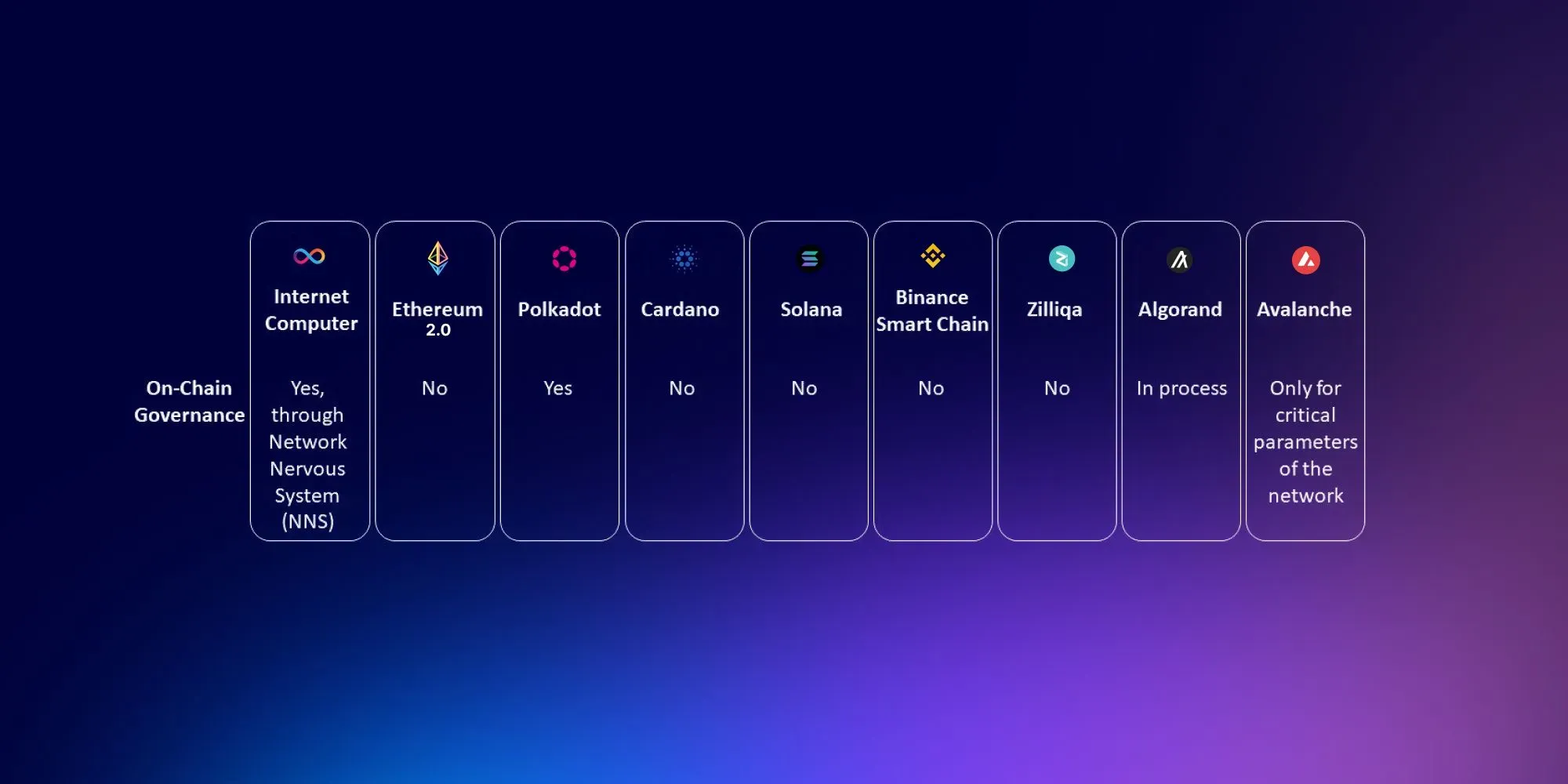
The Internet Computer uses an algorithmic governance system called the Network Nervous System (NNS), sometimes referred to as the 'world's largest DAO' that allows ICP holders to lock tokens within it to create "neurons." These neurons provide voting rights on proposals like this one which affects the network's operation and gives participants rewards in the form of additional ICP tokens.
The network's community actively directs the effort to make the network more efficient, faster, and easier for developers. Technical upgrades are subject to community discussion, voting, and approval via motion proposals to the Network Nervous System.
Recently, Justin Bons concluded that only nine of the top 50 cryptocurrencies by market cap have their own on-chain governance.
Credit where credit is due, out of the top fifty cryptocurrencies by market cap;
— Justin Bons (@Justin_Bons) January 16, 2023
Nine have successfully implemented on-chain governance:#DOT, #ATOM, #TON, #LIDO, #ALGO, #ICP, #AAVE, #EOS & #XTZ
Congratulations, you are the future! Adopt governance to support decentralization
Of all the blockchains proposed in this article, only Polkadot, Algorand and ICP have a governance system, although Avalanche has a limited version that only governs critical network parameters. Only a predetermined number of parameters can be modified via governance, such as the minimum staking amount, minting rate, and other economic parameters, hence why it isn't featured in the analysis of Justin Bons.
According to Dominic Williams, Chief Scientist at DFINITY, at this stage, over 123 million ICP are locked for a maximum of 8 years, representing a total of over a quarter of the total supply in order to generate governance rewards (essentially a form of interest derived from voting).
Internet Computer | #ICP blockchain is self-governing & updating
— dom.icp ∞ (@dominic_w) November 21, 2022
123.3 million $ICP is locked minimum 8 years inside the Network Nervous System DAO #WorldComputer governance system. This secures network management, and reflects the ecosystem's strength
Governance TVL is HUGE💪 pic.twitter.com/s5DU79RH2R
Staking Rewards
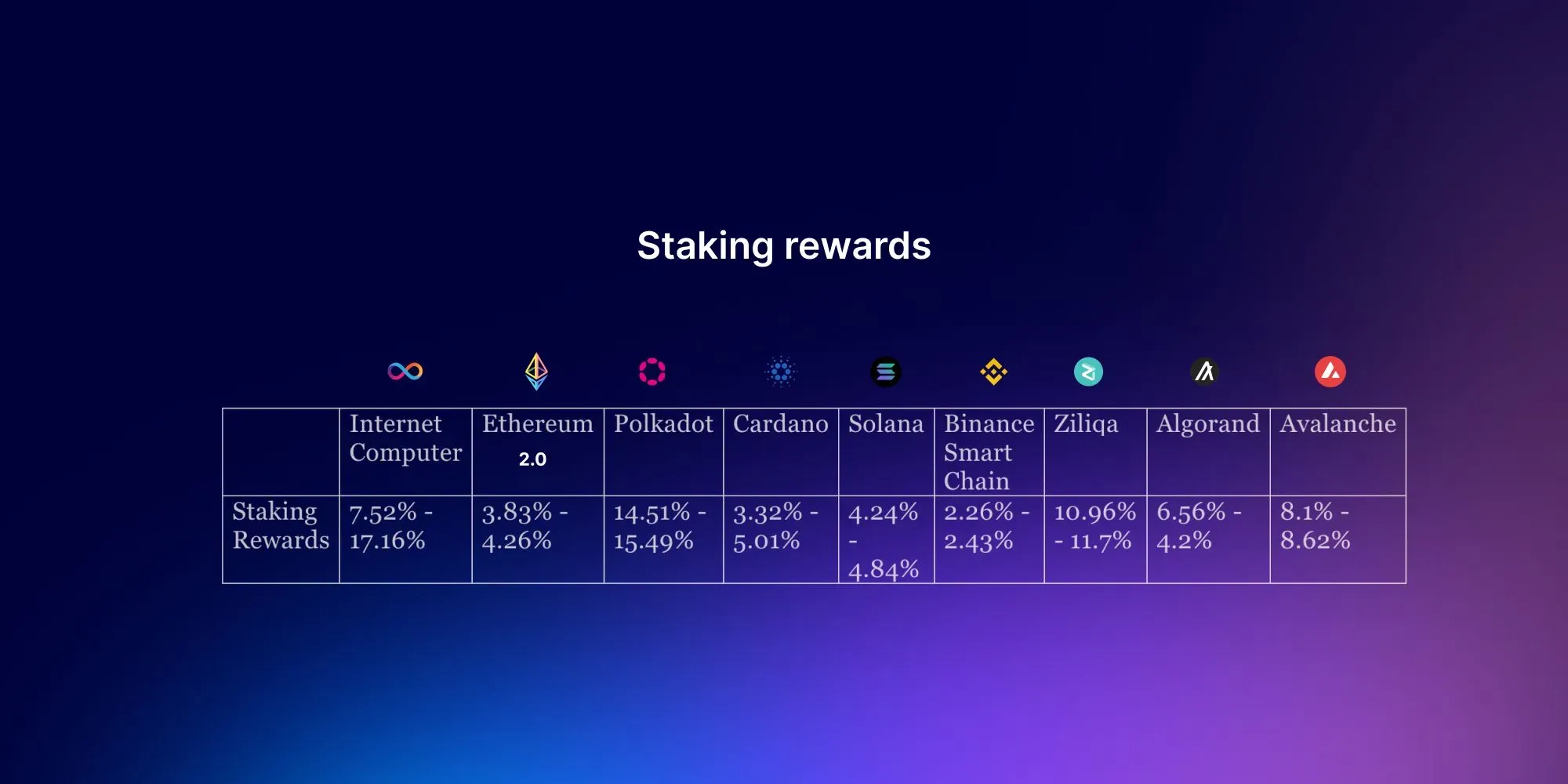
Source - https://www.stakingrewards.com/
Staking is the process of locking up crypto holdings for a designated period to earn rewards. Once you have staked your assets, you can earn staking rewards on top of your holdings and grow them further by compounding those future rewards.
As you can see in the table above, the Internet Computer offers the highest return for long-term stakes, ranging from 7.52% per year for 6-month staking to 17.16% per year for 8-year staking based on current figures. This has given rise to the '8-Year Gang' hashtag in the ICP community due to the long-term passive income potential for long-term investment.
Consult the ICP Neuron Calculator to determine the returns you will obtain according to your objectives. The following guide provides you with a step-by-step explanation of how to stake ICP tokens using the Network Nervous System (NNS).
Supply and Launch Dates
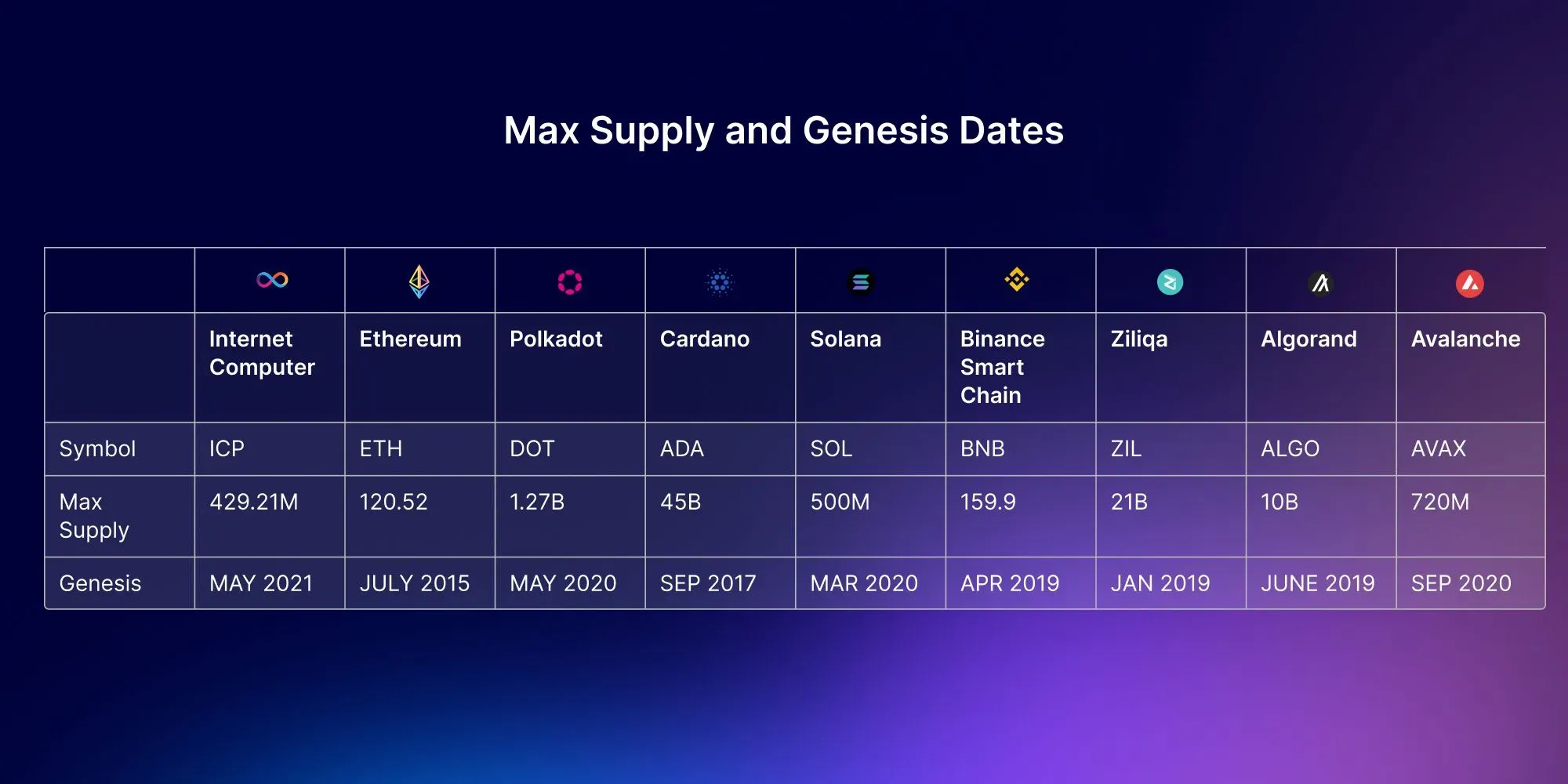
The Current Supply of $ICP is 469.21 million, and the inflation was theoretically meant to start at 10% and then stabilize at 5% over the years, though there is much discussion around the actual figure at present. A December 2022 article produced by DFINITY statistician Kyle Langham in the Internet Computer Review postulates that ICP inflation has been very low over the last year.
ICP token inflation is caused by the minting of ICP to reward node providers and to reward NNS governance participants. The annualized inflation rate for ICP from January through December 2022 has been 3.6%, which is well below the targeted inflation rate for governance rewards of 8–9% annualized. Many NNS participants have been accumulating their rewards as “maturity” (i.e., the accrual of rewards in a neuron from voting on proposals) instead of converting them into ICP tokens
Cycles burning to power the dapps will increasingly drive deflation as the number of daily active users rises, so the more successful the ecosystem is at driving adoption and network effects, the more deflationary ICP will become, and this will obviously correlate with price action.
Conclusion
The main innovation behind the Internet Computer is Chain Key cryptography, which encompasses several new technologies, including the consensus mechanism, Non-Interactive Distributed Key Generation (NI-DKG), Network Nervous System (NNS), Internet Identity, and more. This technology is also fundamental to the groundbreaking integration of Bitcoin and, soon, Ethereum on the Internet Computer chain. HTTP outcalls now also allow web3 and web2 to seamlessly interact on the IC, similar to Chainlink functionality.
Many so-called ‘Ethereum killer’ blockchains add changes that improve some of the features that Ethereum offers, such as the speed or fees. However, the Internet Computer presents innovative changes in all the bases that will transform the existing technology. The Internet Computer aims to enhance Ethereum as a sister network rather than compete with it, empowering the wider crypto space and healing tribal divisions.
Many of the blockchains mentioned in this article will coexist for the foreseeable, having gained a first-mover advantage. Thereafter, those that bring the most advances and solutions to issues prevalent within blockchain technology, such as hackable bridges in DeFi will remain relevant.
The Internet Computer offers the world a new paradigm and technology with revolutionary achievements such as the integration of Bitcoin and the implementation of HTTP outcalls, along with the eagerly anticipated Ethereum integration that will likely be finalized before Q3 2023.
The Internet Computer is the fastest blockchain by some margin, with a finality time of 2 seconds and a query call of 100 ms. Its canister smart contracts offer a real web 3.0 serving the web and interacting directly with users. Scalability is unlimited, and it provides a highly adaptable blockchain that allows its community to vote on proposals through the Network Nervous System to manage the Internet Computer. These are just some of its innovative and robust features!
Finally, over 25% of the total supply is already locked for 8 years, and dApps powered by cycles will eventually make the ICP token deflationary. Meanwhile, those entering at low entry prices can lock their ICP as an investment if they wish in order to gain an exceptional ROI.
We hope we made it clear why we are building on ICP and why it stands head and shoulders above the rest. We are convinced that it is only a matter of time before the wider crypto world realizes this and network effects explode exponentially; indeed, the beginnings of this already appear to be underway.
The future is bright with the Internet Computer. InfinitySwap will leverage its fantastic technical achievements to bring the world the next iteration of decentralized finance with secure, high-speed, and low-fee transactions.
Connect with InfinitySwap
Bitfinity Wallet |AMM | Twitter | Website | Telegram | Discord | Github

*Data, graphics, and information have been updated and edited from the original viral post at Dfinity Community (now rebranded to Coinhustle). We thank our partner for the original input in this joint publication.
*Disclaimer: Please note that this list of L1s is not exhaustive, and more chains can be added at a request in the future. In fact, we will aim to update this article every six months, at the very least, adding more analysis via continuous iteration. Also, while the research was meticulous, we are open to edits if and where appropriate, especially as certain metrics, such as speed will change over time.




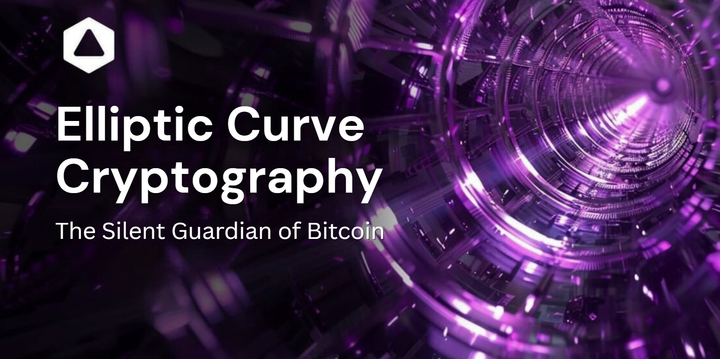
Comments ()